 |
|||
Gene "Eneg" Bilbrew Der afroamerikanische Illustrator, Comiczeichner und Fetischkünstler Gene (Eugene) Bilbrew wurde am 29. Juni 1923 in Los Angeles geboren. Im Laufe seiner Karriere arbeitete er neben seinem Familiennamen auch unter den Pseudonymen ENEG (Gene rückwärts geschrieben), Van Rod und Bondy. Bilbrew lernte sein Handwerk auf der School of Visual Arts in New York City - unter anderem bei keinem Geringeren als Burne Hogarth. Seinen ersten größeren Auftrag als Zeichner bekam Bilbrew nach einem Treffen mit Bill Alexander, der für die afroamerikanische Zeitung Los Angeles Sentinel den Comicstrip "The Bronze Bomber" betreute. Späterhin zeichnete er für die Serie "Hercules", die im Health Magazin erschien. Um das Jahr 1950 wurde Bilbrew Assistent von Will Eisner, der mit seiner Serie "The Spirit" große Erfolge feierte. Zudem übernahm er für Jules Feiffer, der seinen Militärdienst antrat, die Serie "Clifford". Bekannt wurde Bilbrew in den folgenden Jahren durch seine Zusammenarbeit mit dem Fetischfotografen Irving Klaw. Die Verbindung zu Klaws Vertriebsfirma Movie Star News hatte er Eric Stanton zu verdanken, der zeitgleich mit Bilbrew auf der New Yorker Kunstakademie war und beide sich seit dieser Zeit kannten. Zwischen den Jahren 1956 und 1959 gestaltete Bilbrew etliche Illustrationen und Titelcover für das Fetischmagazin Exotique, herausgegeben von Leonard "Lenny" Burtman. Die Zeichnungen zeigten überwiegend Darstellungen weiblicher Dominanz und diverse Bondage-Szenen. In dieser Zeit entstanden auch Bilbrews Schöpfungen wie Princess Elaine oder Madame La Bondage. Neben dem Exotique Magazin arbeitete er zudem für die Fetisch-Publikationen Fantasia und Ultra. Für das Fantasia Magazin zeichnete Bilbrew die Comic Serie "Camper´s Capers", die ab der Ausgabe 11 bis zum Ende des Blattes mit der Nummer 20 lief. In den 1960er Jahren began er Cover-Illustrationen für sogenannte "Sleaze Paperbacks" zu produzieren, die unter anderem bei Stanley Malkin und Eddy Mishkins Satellite Productions erschienen. Bilbrew arbeitete für das New Yorker Unternehmen in den Jahren 1963 bis 1967. Er illustrierte dabei etliche Titel - unter anderem für die Labels "After Hour", "First Niter", "Nitey Nite", "Unique Books" und "Wee Hours". (1) Neben Satellite arbeitete Bilbrew auch für Joe Sturmans Connoisseur Publications und zeichnete Covers für die Pulp-Labels (also eigenständige Marken innerhalb eines Verlages) Chevron, Corsair, Crescent, Exotik, Mercury, Thantom, Wizard, Vanguard, sowie Satan Press, für die er jedes Magazincover illustrierte. (1) Ende der 1960er Jahre stieg Sturman aus dem "Porno"-Biz aus und übergab das Geschäft seinem Bruder Reuben. Dieser stellte die Labels für die Bilbrew arbeitete ein. Nach der Pleite von Satellite und später Connoisseur begann auch der Niedergang von Bilbrew. Zwar konnte er noch für Euro Classics, Tortura Press, Spade Classics oder Dr. Lamb Library arbeiten, doch der Niedergang der "Sleaze"-Bücher war nicht mehr aufzuhalten. Zunehmend verwendeten viele Verleger statt aufweniger Illustrationen kostengünstige Fotografien für ihre Titel. (1) Über sein Privatleben ist recht wenig überliefert, aber es war bekannt, das Bilbrew ein Freund des Alkohols und der härteren Drogen war. Zudem verkehrte er mit etlichen Frauen; überweigend weißen Frauen. Denn Bilbrew wollte - laut einer Einschätzung von Eric Stanton - eigentlich lieber ein Weißer sein. Der komplette persönliche Absturz und sein Tod waren dann auch seiner Drogenabhängigkeit geschuldet. Bilbrew verstarb im Mai 1974 in einem Hinterzimmer in einem von Eddy Mishkins Pornobuchläden in New York an einer Überdosis Heroin. "… so if you choose to google him up with your preferences open, you might be disturbed. There are literally thousands of entries on Bilbrew and his work on the web, and yet the "real" art world seems to know virtually nothing about him. This may be due to his "way outside the norm" life and body of work, but it could just as easily be due to his race or the fact that virtually none of his original work survives." (2) Eric Stanton, John Willie und Gene Bilbrew haben als "die großen Drei" durch ihre Arbeiten das Fetisch- und Bondage-Genre - vor allem in den 1950/60er Jahren - nachhaltig geprägt. Die Comics und Illustrationen Bilbrews aus den 1950er Jahren zeigen fetisch-typische Frauenbilder mit eleganten, schlanken und langbeinigen Dominas und ebengleichen "Opfern". Hier sieht man den Einfluß von Irving Klaws Arbeiten und seinen Modellen (allen voran Betty Page). Etliche Zeichnungen wirken mit heutigen Augen gesehen durchaus modern. Ganz anders die späteren Coverillustrationen für die Sleaze-/Pulp-Bücher. Bilbrews weibliche Charaktere verwandelten sich zu dominaten, beherrschenden "Amazonen" mit kurvenreichen Konturen, muskulösen Armen und Beinen und ausladenden Hinterteilen und Brüsten. Die Gesichter (auch die der Männer) waren oftmals streng, kantig und fast fratzenhaft gestaltet. Dazu kamen hochtoupierte Frisuren aus der Zeit der 1960er Jahre, die diesen unterkühlten Look verstärkten. Trotz der durch Alkohol und Drogen geschuldeten Qualitätseinbrüche in den letzten Jahren seiner Karriere zeigte Bilbrew eine variantenreiche, auch unverwechselbare künstlerische Palette, mit erkennbaren Einflüssen durch Kollegen und Wegbegleitern. Veröffentlichungen in Frankreich/Italien (Auswahl/Selection) (3): Links: Bücher über Bilbrew: Quellen/Sources: |
This translation is unedited!
Genes "Eneg" Bilbrew
The African American illustrator, comic-strip artist and fetish artist Gene (Eugene) Bilbrew was born in Los Angeles on 29 June 1923. In the course of his career, he worked not only under his family name but also under the pseudonyms ENEG (genes written backwards), Van Rod and Bondy.
Bilbrew studied his craft at the School of Visual Arts in New York City - among others with none other than Burne Hogarth.
Bilbrew received his first major commission as a draughtsman after a meeting with Bill Alexander, who was in charge of the comic strip "The Bronze Bomber" for the African American newspaper Los Angeles Sentinel. Later he drew for the series "Hercules", which appeared in Health magazine. Although Bilbrew wanted to be a singer on stage, this dream came true and he didn't get beyond a few supporting roles in various stage shows.
Around 1950 Bilbrew became assistant to Will Eisner, who had great success with his series "The Spirit". He also took over the series "Clifford"for Jules Feiffer, who started his military service.
Bilbrew became famous in the following years through his collaboration with the fetish photographer Irving Klaw. He had the connection to Klaw's distributor Movie Star News thanks to Eric Stanton, who was at the same time as Bilbrew at the New York Academy of Art and both knew each other since that time.
Between 1956 and 1959 Bilbrew designed several illustrations and covers for the fetish magazine Exotique, edited by Leonard "Lenny" Burtman. The drawings showed mainly representations of female dominance and various bondage scenes. During this time Bilbrew's creations such as Princess Elaine or Madame La Bondage were created. In addition to the Exotique magazine, he also worked for the fetish publications Fantasia and Ultra. For the Fantasia Magazine, Bilbrew drew the comic series "Campers Capers", which ran from issue 11 to the end of the sheet with number 20.
In the 1960s he began to produce cover illustrations for so-called "Sleaze Paperbacks", which were published by Stanley Malkin and Eddy Mishkin's Satellite Productions. Bilbrew worked for the New York-based company from 1963 to 1967, illustrating a number of titles including After Hour, First Niter, Nitey Nite, Unique Books and Wee Hours. (1)
In addition to Satellite, Bilbrew also worked for Joe Sturmans Connoisseur Publications and designed covers for the pulp labels (i. e. independent brands within a publishing house) Chevron, Corsair, Crescent, Exotik, Mercury, Thantom, Wizard, Vanguard, and Satan Press, for which he illustrated every magazine cover. (1)
At the end of the 1960s, Sturman left the "porn"-biz and handed over the business to his brother Reuben. He stopped the labels for the Bilbrew.
After the bankruptcy of Satellite and later Connoisseur also began the decline of Bilbrew. Although he could still work for Euro Classics, Tortura Press, Spade Classics or Dr. Lamb Library, the decline of the "Sleaze"books was unstoppable. Increasingly, many publishers are using inexpensive photographs for their titles instead of less illustrations. (1)
About his private life is quite little reported, but it was known that Bilbrew was a friend of alcohol and harder drugs. He also interfered with a number of women, mostly white women. According to Eric Stanton, Bilbrew would rather be a white man than a white man. The complete personal crash and his death were then also due to his drug addiction.
Bilbrew died in May 1974 in a backroom in one of Eddy Mishkin's porn bookshops in New York from an overdose of heroin.
"... so if you choose to google him up with your preferences open, you might be disturbed. There are literally thousands of entries on Bilbrew and his work on the web, and yet the "real" art world seems to know virtually nothing about him. This may be due to his "way outside the norm" life and body of work, but it could just as easily be due to his race or the fact that virtually none of his original work survives." (2)
Eric Stanton, John Willie and Gene Bilbrew have left a lasting mark on the fetish and bondage genre as "the big three" through their work, especially in the 1950s/60s.
Bilbrew's comics and illustrations from the 1950s show typical fetish images of women with elegant, slender and long-legged dominas and equal "victims". Here you can see the influence of Irving Klaw's works and his models (especially Betty Page). Many of the drawings look quite modern with today's eyes. The later cover illustrations for the Sleaze/Pulp books are completely different.
Bilbrew's female characters turned into dominant, dominating "amazons" with curvy contours, muscular arms and legs and sweeping buttocks and breasts. The faces (including those of the men) were often strict, angular and almost facial. In addition, there were highly toppled hairstyles from the 1960s, which reinforced this super-cooled look.
Despite the quality slumps caused by alcohol and drugs in recent years, Bilbrew showed a varied and unmistakable artistic palette, with recognisable influences from colleagues and companions. |
||||||||||||||
 |
|||||||||||||||
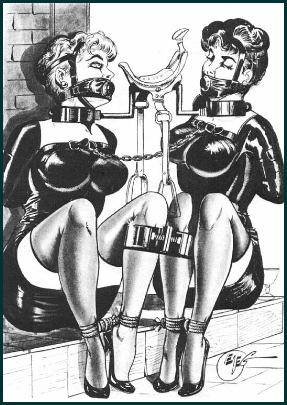 |
 |
||||||||||||||
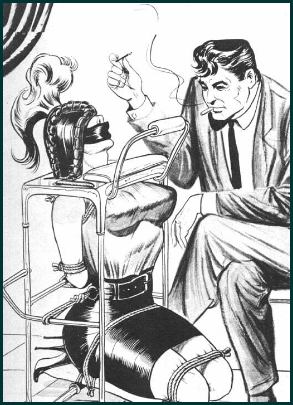 |
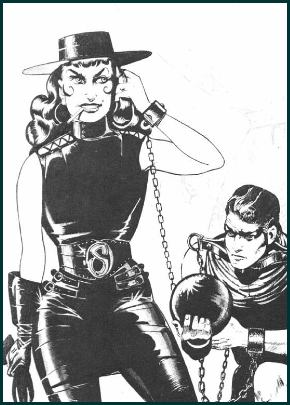 |
||||||||||||||
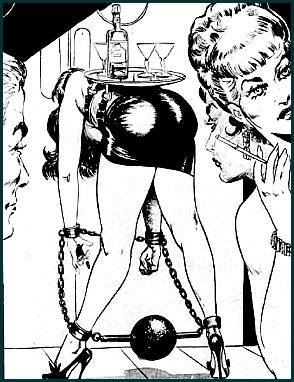 |
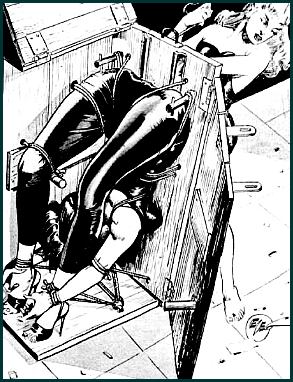 |
|||
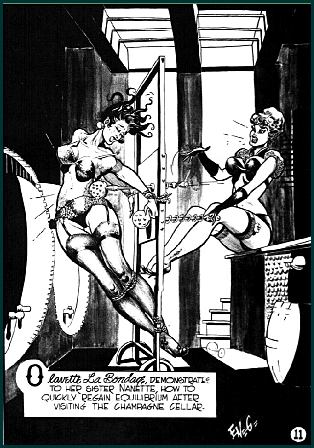 |
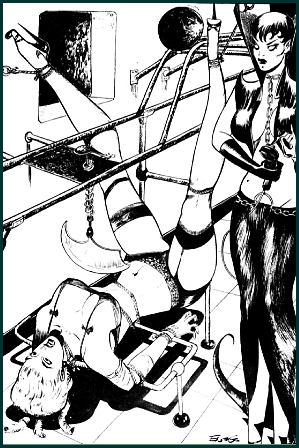 |
|||
 |
||
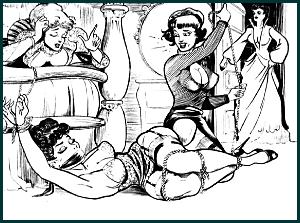 |
||
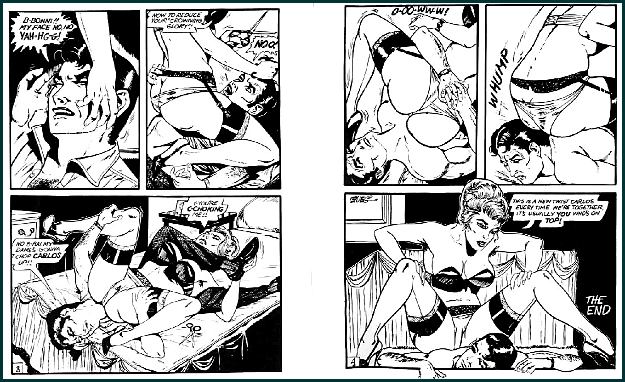 |
||
 |
||
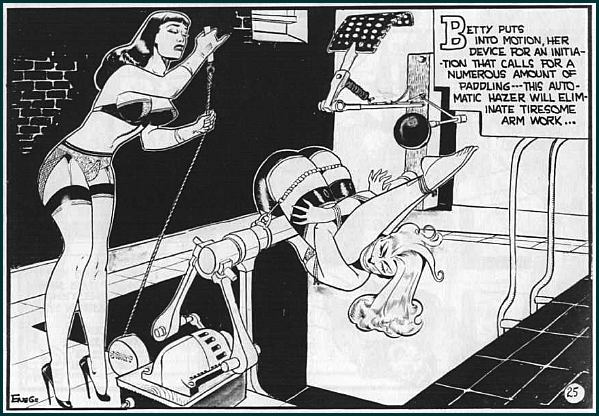 |
||